+ Open data
Open data
- Basic information
Basic information
| Entry | Database: PDB / ID: 1qwi | ||||||
|---|---|---|---|---|---|---|---|
| Title | Crystal Structure of E. coli OsmC | ||||||
 Components Components | osmotically inducible protein | ||||||
 Keywords Keywords | hydroperoxide reductase / hydroperoxide resistance | ||||||
| Function / homology |  Function and homology information Function and homology informationperoxiredoxin activity / hyperosmotic response / response to hydroperoxide / Oxidoreductases; Acting on a peroxide as acceptor; Peroxidases / peroxidase activity / response to oxidative stress / protein homodimerization activity / cytosol Similarity search - Function | ||||||
| Biological species |  | ||||||
| Method |  X-RAY DIFFRACTION / X-RAY DIFFRACTION /  SYNCHROTRON / SYNCHROTRON /  MAD / Resolution: 1.8 Å MAD / Resolution: 1.8 Å | ||||||
 Authors Authors | Lesniak, J. / Barton, W.A. / Nikolov, D.B. | ||||||
 Citation Citation |  Journal: Protein Sci. / Year: 2003 Journal: Protein Sci. / Year: 2003Title: Structural and functional features of the Escherichia coli hydroperoxide resistance protein OsmC Authors: Lesniak, J. / Barton, W.A. / Nikolov, D.B. | ||||||
| History |
|
- Structure visualization
Structure visualization
| Structure viewer | Molecule:  Molmil Molmil Jmol/JSmol Jmol/JSmol |
|---|
- Downloads & links
Downloads & links
- Download
Download
| PDBx/mmCIF format |  1qwi.cif.gz 1qwi.cif.gz | 122.7 KB | Display |  PDBx/mmCIF format PDBx/mmCIF format |
|---|---|---|---|---|
| PDB format |  pdb1qwi.ent.gz pdb1qwi.ent.gz | 96 KB | Display |  PDB format PDB format |
| PDBx/mmJSON format |  1qwi.json.gz 1qwi.json.gz | Tree view |  PDBx/mmJSON format PDBx/mmJSON format | |
| Others |  Other downloads Other downloads |
-Validation report
| Summary document |  1qwi_validation.pdf.gz 1qwi_validation.pdf.gz | 381.9 KB | Display |  wwPDB validaton report wwPDB validaton report |
|---|---|---|---|---|
| Full document |  1qwi_full_validation.pdf.gz 1qwi_full_validation.pdf.gz | 387.4 KB | Display | |
| Data in XML |  1qwi_validation.xml.gz 1qwi_validation.xml.gz | 11.3 KB | Display | |
| Data in CIF |  1qwi_validation.cif.gz 1qwi_validation.cif.gz | 21.1 KB | Display | |
| Arichive directory |  https://data.pdbj.org/pub/pdb/validation_reports/qw/1qwi https://data.pdbj.org/pub/pdb/validation_reports/qw/1qwi ftp://data.pdbj.org/pub/pdb/validation_reports/qw/1qwi ftp://data.pdbj.org/pub/pdb/validation_reports/qw/1qwi | HTTPS FTP |
-Related structure data
| Related structure data | |
|---|---|
| Similar structure data |
- Links
Links
- Assembly
Assembly
| Deposited unit | 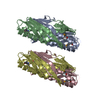
| ||||||||
|---|---|---|---|---|---|---|---|---|---|
| 1 | 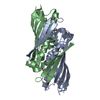
| ||||||||
| 2 | 
| ||||||||
| Unit cell |
|
- Components
Components
| #1: Protein | Mass: 15275.818 Da / Num. of mol.: 4 Source method: isolated from a genetically manipulated source Source: (gene. exp.)   #2: Water | ChemComp-HOH / | Has protein modification | Y | |
|---|
-Experimental details
-Experiment
| Experiment | Method:  X-RAY DIFFRACTION / Number of used crystals: 1 X-RAY DIFFRACTION / Number of used crystals: 1 |
|---|
- Sample preparation
Sample preparation
| Crystal | Density Matthews: 2.33 Å3/Da / Density % sol: 47.26 % | ||||||||||||||||||||||||||||||||||||||||||
|---|---|---|---|---|---|---|---|---|---|---|---|---|---|---|---|---|---|---|---|---|---|---|---|---|---|---|---|---|---|---|---|---|---|---|---|---|---|---|---|---|---|---|---|
| Crystal grow | Temperature: 297 K / Method: vapor diffusion, hanging drop / pH: 6 Details: PEG 5000 MME, 0.2M Ammonium sulfate, pH 6.0, VAPOR DIFFUSION, HANGING DROP, temperature 297K | ||||||||||||||||||||||||||||||||||||||||||
| Crystal grow | *PLUS Temperature: 4 ℃ / pH: 8 / Method: vapor diffusion, hanging drop | ||||||||||||||||||||||||||||||||||||||||||
| Components of the solutions | *PLUS
|
-Data collection
| Diffraction | Mean temperature: 100 K | ||||||||||||
|---|---|---|---|---|---|---|---|---|---|---|---|---|---|
| Diffraction source | Source:  SYNCHROTRON / Site: SYNCHROTRON / Site:  NSLS NSLS  / Beamline: X9A / Wavelength: 0.9795, 0.9793, 0.9770 / Beamline: X9A / Wavelength: 0.9795, 0.9793, 0.9770 | ||||||||||||
| Detector | Type: MAR CCD 165 mm / Detector: CCD / Date: Dec 1, 2001 | ||||||||||||
| Radiation | Monochromator: SAGITALLY FOCUSED Si(111) / Protocol: MAD / Monochromatic (M) / Laue (L): M / Scattering type: x-ray | ||||||||||||
| Radiation wavelength |
| ||||||||||||
| Reflection | Resolution: 1.8→30 Å / Num. all: 51960 / Num. obs: 48947 / % possible obs: 94.2 % / Observed criterion σ(F): 0 / Observed criterion σ(I): 0 / Rmerge(I) obs: 0.053 / Rsym value: 0.045 | ||||||||||||
| Reflection shell | Resolution: 1.8→1.88 Å / % possible all: 94.8 | ||||||||||||
| Reflection | *PLUS % possible obs: 99.7 % / Redundancy: 2.1 % / Rmerge(I) obs: 0.039 | ||||||||||||
| Reflection shell | *PLUS Highest resolution: 2 Å / Lowest resolution: 2.09 Å / % possible obs: 98.7 % |
- Processing
Processing
| Software |
| |||||||||||||||||||||||||
|---|---|---|---|---|---|---|---|---|---|---|---|---|---|---|---|---|---|---|---|---|---|---|---|---|---|---|
| Refinement | Method to determine structure:  MAD / Resolution: 1.8→20 Å / Cross valid method: THROUGHOUT / σ(F): 0 / σ(I): 0 / Stereochemistry target values: Engh & Huber / Details: Freidel pairs were used in refinement. MAD / Resolution: 1.8→20 Å / Cross valid method: THROUGHOUT / σ(F): 0 / σ(I): 0 / Stereochemistry target values: Engh & Huber / Details: Freidel pairs were used in refinement.
| |||||||||||||||||||||||||
| Refinement step | Cycle: LAST / Resolution: 1.8→20 Å
| |||||||||||||||||||||||||
| Refinement | *PLUS Lowest resolution: 500 Å / Num. reflection obs: 93520 / Rfactor Rfree: 0.24 / Rfactor Rwork: 0.22 | |||||||||||||||||||||||||
| Solvent computation | *PLUS | |||||||||||||||||||||||||
| Displacement parameters | *PLUS | |||||||||||||||||||||||||
| Refine LS restraints | *PLUS
| |||||||||||||||||||||||||
| LS refinement shell | *PLUS Highest resolution: 2 Å / Lowest resolution: 2.09 Å |
 Movie
Movie Controller
Controller




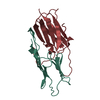
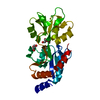

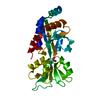

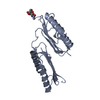
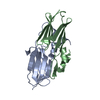

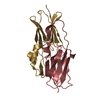

 PDBj
PDBj
